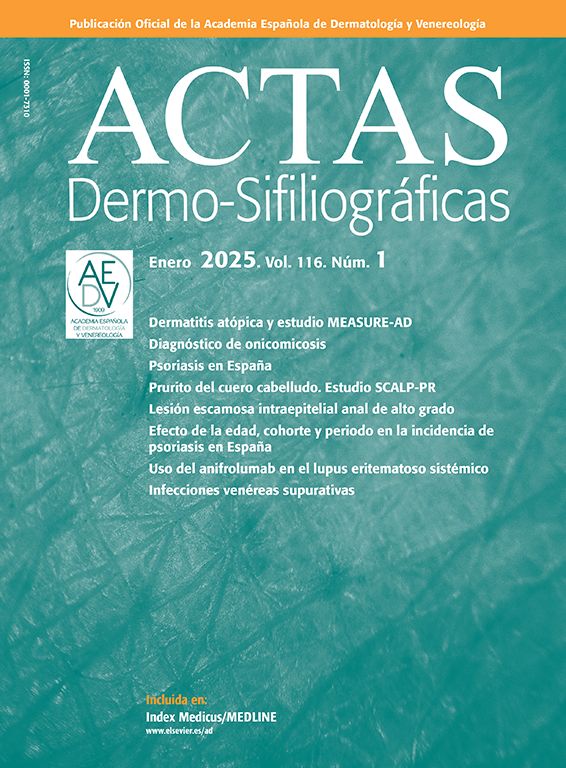To the Editor:
The presence of widespread pustules in newborns often suggests a serious infection. However, there is also a benign, inflammatory form of neonatal pustulosis. We report a case of transient neonatal pustular melanosis (TNPM), a self-limiting condition that affects full-term newborns and is characterized by the appearance of multiple sterile pustules distributed over the whole body surface.
A full-term newborn boy delivered by cesarean section and aged 12hours was referred to our department from the pediatric unit to evaluate a vesiculopustular skin rash that was present at birth. On physical examination we observed numerous pustules on normal skin measuring between 1mm and 5mm in diameter and located on the scalp, face, chin, neck, trunk, buttocks, and proximal third of the lower limbs (Figs. 1 and 2). Some of the lesions no longer contained fluid and consisted of superficial crusts on an area of brownish skin (Fig. 2). The patient did not present fever or any other abnormal signs and a sterile pustular rash was initially suspected. The patient was treated solely with topical mupirocin to avoid secondary bacterial infection. A differential diagnosis was made with vertical transmission of bacterial infection (Staphylococcus aureus, Streptococcus pyogenes, Pseudomonas species, listeriosis), fungal infection (candidiasis), viral infection, and syphilis. These conditions were ruled out by additional testing. Blood cultures and serology were negative for herpes simplex virus (HSV), varicella zoster virus (VZV), cytomegalovirus, and syphilis. Samples were taken from 2 pustules and urgent Tzanck test and Gram stain were carried out. Part of the exudate was sent for microbiological culture and polymerase chain reaction for HSV and VZV. The Tzanck and Gram studies showed abundant polymorphonuclear cells and normal epithelial cells with no cytological sign of infection. All other additional test results were normal. At 48hours after birth few pustules remained, the established lesions showed peripheral desquamation, and the newborn presented excellent general health. At 4 days the condition had resolved, with only hyperpigmented macules visible in areas where the pustules had been. Based on these data, a final diagnosis of TNPM was made.
TNPM is a rare disorder with a worldwide prevalence in newborn infants of less than 1%.1–3 It affects both sexes equally and is more common in black infants, in whom the incidence is 4.4%.3,4 The etiology of TNPM is unknown and no association with maternal infections or exposure to toxic substances has been detected.4,5
Clinically, TNPM is characterized by the appearance of vesicles and pustules on a background of healthy skin that is not erythematous.4,5 The areas most frequently affected are the forehead, temporal regions, cheeks, neck, back, and buttocks; involvement of the palms and soles is very rare.2,4 The initial lesions usually disappear spontaneously within the first 2 weeks of life, and no treatment is required. The pustules rupture and leave hyperpigmented macules with collarette scaling that persist for several weeks or even months.4,6 TNPM is not associated with any systemic manifestations.7
The diagnosis is based on clinical findings and screening for other more serious conditions that require urgent antibiotic treatment. Skin biopsy is not usually necessary. TNPM may resemble various other skin rashes in newborns, such as neonatal toxic erythema (NTE), acne neonatorum, and eosinophilic pustular folliculitis, and it is essential to rule out systemic infection in patients presenting with these alterations.1,3,8,9 In NTE, in contrast to TNPM, the pustules are located on a background of erythematous skin and peripheral eosinophilia may be present. Histologically, TNPM presents as subcorneal or intraepidermal pustules composed mainly of neutrophils; this finding helps to differentiate TNPM from NTE, in which there is a predominance of eosinophils.1,3,7,10
In conclusion, we must be aware that TNPM is a benign condition with no systemic manifestations and it does not require treatment. This entity can be confused with serious infections, and patients with TNPM may be administered empirical antibiotic treatment or undergo invasive tests. It is essential that pediatricians and dermatologists are aware of TNPM in order to avoid unnecessary additional tests or treatments.
Please cite this article as: Agusti-Mejias A, et al. Melanosis pustulosa transitoria del recién nacido. Actas Dermosifiliogr.2013;104:84-5.









